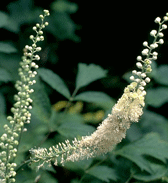Back to: Health Information : Health Topics A–Z

Black Cohosh
Keywords: black snakeroot, macrotys, bugbane, bugwort, rattleroot, rattleweed, menopause

® 2004 Horticopia, Inc. Photography by Robert E. Lyons
On this page
- Introduction
- What It Is Used For
- How It Is Used
- What the Science Says
- Side Effects and Cautions
- Sources
- For More Information
Introduction
This fact sheet provides basic information about the herbA plant or part of a plant used for its flavor, scent, or potential therapeutic properties. Includes flowers, leaves, bark, fruit, seeds, stems, and roots. black cohosh—common names, uses, potential side effects, and resources for more information. Black cohosh, a member of the buttercup family, is a plant native to North America. It was used in Native American medicine and was a home remedy in 19th-century America.
Common Names—black cohosh, black snakeroot, macrotys, bugbane, bugwort, rattleroot, rattleweed
Latin Names—Actaea racemosa, Cimicifuga racemosa
What It Is Used For
- Black cohosh has a history of use for rheumatism (arthritis and muscle pain) but has been used more recently to treat hot flashes, night sweats, vaginal dryness, and other symptoms that can occur during menopause.
- Black cohosh has also been used for menstrual irregularities and premenstrual syndrome, and to induce labor.
How It Is Used
The underground stems and roots of black cohosh are commonly used fresh or dried to make strong teas (infusions), capsules, solid extracts used in pills, or liquid extracts (tinctures).
What the Science Says
- Study results are mixed on whether black cohosh effectively relieves menopausal symptoms. An NCCAM-funded study found that black cohosh, whether used alone or with other botanicals, failed to relieve hot flashes and night sweats in postmenopausal women or those approaching menopause.
- Most studies to date have been less than 6 months long, so the safety of long-term use is unknown.
- NCCAM is funding studies to further understand the potential effects of black cohosh on hot flashes and other menopausal symptoms.
- There are not enough reliable data to determine whether black cohosh is effective for rheumatism or other uses.
Side Effects and Cautions
- Black cohosh can cause headaches and stomach discomfort. In clinical trials comparing the effects of the herb and those of estrogens, a low number of side effects were reported, such as headaches, gastric complaints, heaviness in the legs, and weight problems.
- No interactions have been reported between black cohosh and prescription medicines.
- Black cohosh has been linked to a few cases of hepatitis (inflammation of the liver), but it is not clear whether black cohosh caused the problem.
- It is not clear if black cohosh is safe for women who have had breast cancer or for pregnant women.
- Black cohosh should not be confused with blue cohosh (Caulophyllum thalictroides), which has different properties, treatment uses, and side effects than black cohosh. Black cohosh is sometimes used with blue cohosh to stimulate labor, but this therapy has caused adverse effects in newborns, which appear to be due to blue cohosh.
- Tell your health care providers about any complementary and alternative practices you use. Give them a full picture of what you do to manage your health. This will help ensure coordinated and safe care.
Sources
- Newton KM, Reed SD, LaCroix AZ, et al. Treatment of vasomotor symptoms of menopause with black cohosh, multibotanicals, soy, hormone therapy, or placebo: a randomized trial. Annals of Internal Medicine. 2006;145(12):869–879.
- Office of Dietary Supplements and National Center for Complementary and Alternative Medicine. Questions and Answers About Black Cohosh and the Symptoms of Menopause. Office of Dietary Supplements Web site. Accessed on July 2, 2007.
- National Center for Complementary and Alternative Medicine and Office of Dietary Supplements. Workshop on the Safety of Black Cohosh in Clinical Studies. National Center for Complementary and Alternative Medicine Web site. Accessed on July 2, 2007.
- Natural Medicines Comprehensive Database. Black cohosh. Natural Medicines Comprehensive Database Web site. Accessed on June 29, 2007.
- Natural Standard Database. Black cohosh (Cimicifuga racemosa [L.] Nutt.). Natural Standard Database Web site. Accessed June 28, 2007.
- Black cohosh root. In: Blumenthal M, Goldberg A, Brinckman J, eds. Herbal Medicine: Expanded Commission E Monographs. Newton, MA: Lippincott Williams & Wilkins; 2000:22–26.
For More Information
- What's in the Bottle? An Introduction to Dietary Supplements
- Herbal Supplements: Consider Safety, Too
NCCAM Clearinghouse
The NCCAM Clearinghouse provides information on CAM and NCCAM, including publications and searches of Federal databases of scientific and medical literature. The Clearinghouse does not provide medical advice, treatment recommendations, or referrals to practitioners.
Toll-free in the U.S.: 1-888-644-6226
TTY (for deaf and hard-of-hearing callers): 1-866-464-3615
Web site: nccam.nih.gov
E-mail:
CAM on PubMed
Web site: nccam.nih.gov/camonpubmed/
NIH Office of Dietary Supplements
Web site: ods.od.nih.gov
This publication is not copyrighted and is in the public domain. Duplication is encouraged.
NCCAM has provided this material for your information. It is not intended to substitute for the medical expertise and advice of your primary health care provider. We encourage you to discuss any decisions about treatment or care with your health care provider. The mention of any product, service, or therapy is not an endorsement by NCCAM. |
NCCAM Publication No. D268
Created July 2005
Updated March 2008
Note: The PDF file requires a viewer such as Adobe Reader, which you can download free of charge from the Adobe Web site.
